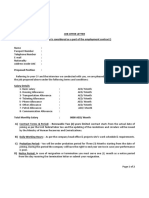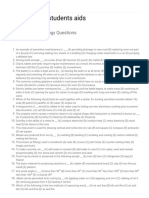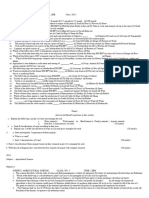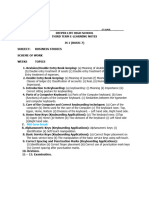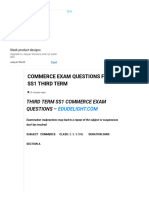0 ratings0% found this document useful (0 votes)
357 viewsHome Economics
Home Economics
Uploaded by
SOMOSCOThis document contains a 21 multiple choice question Home Economics exam for JSS 3 students. The questions cover topics like the manufacturing process of fabric, protein composition, types of sewing machines, macro/micronutrients, protein deficiency diseases, food storage/preservation methods, and meal planning factors. It also includes 3 essay questions requiring definitions, explanations, lists, and differentiations related to food and nutrition concepts.
Copyright:
© All Rights Reserved
Available Formats
Download as DOCX, PDF, TXT or read online from Scribd
Home Economics
Home Economics
Uploaded by
SOMOSCO0 ratings0% found this document useful (0 votes)
357 views2 pagesThis document contains a 21 multiple choice question Home Economics exam for JSS 3 students. The questions cover topics like the manufacturing process of fabric, protein composition, types of sewing machines, macro/micronutrients, protein deficiency diseases, food storage/preservation methods, and meal planning factors. It also includes 3 essay questions requiring definitions, explanations, lists, and differentiations related to food and nutrition concepts.
Copyright
© © All Rights Reserved
Available Formats
DOCX, PDF, TXT or read online from Scribd
Share this document
Did you find this document useful?
Is this content inappropriate?
This document contains a 21 multiple choice question Home Economics exam for JSS 3 students. The questions cover topics like the manufacturing process of fabric, protein composition, types of sewing machines, macro/micronutrients, protein deficiency diseases, food storage/preservation methods, and meal planning factors. It also includes 3 essay questions requiring definitions, explanations, lists, and differentiations related to food and nutrition concepts.
Copyright:
© All Rights Reserved
Available Formats
Download as DOCX, PDF, TXT or read online from Scribd
Download as docx, pdf, or txt
0 ratings0% found this document useful (0 votes)
357 views2 pagesHome Economics
Home Economics
Uploaded by
SOMOSCOThis document contains a 21 multiple choice question Home Economics exam for JSS 3 students. The questions cover topics like the manufacturing process of fabric, protein composition, types of sewing machines, macro/micronutrients, protein deficiency diseases, food storage/preservation methods, and meal planning factors. It also includes 3 essay questions requiring definitions, explanations, lists, and differentiations related to food and nutrition concepts.
Copyright:
© All Rights Reserved
Available Formats
Download as DOCX, PDF, TXT or read online from Scribd
Download as docx, pdf, or txt
You are on page 1of 2
NASIHA ACADEMY EDUCATIONAL SERVICES
2nd TERM EXAMINATION 2023
SUBJECT: HOME ECONOMICS
CLASS: JSS 3
Instruction: Answer all question
1. The last process in the manufacturing process of fabric is a
_________ (a) dyeing (b) carbonizing (c) combing (d) stretching
2. Protein is made up of the element carbon, hydrogen, oxygen and
________ (a) nitrogen (b) sulphur (c) calcium (d) iron
3. ________ is the oldest and slowest type of sewing machine (a) hand
sewing machine (b) treadle sewing machine (c) all of the above
(d) none of the above
4. Macro nutrient are nutrient ________ (a) needed in large quantity
(b) needed in small quantity (c) are not needed at all (d) all of the
above
5. Milk, egg, meat, fish will supply us with _______ protein (a) 1 st class
(b) 2nd class (c) fake (d) original
6. The deficiency disease of protein in children is ___________
(a) kwashiorkor (b) anemia (c) marasmus (d) scurvy
7. The most important equipment for sewing is called __________
(a) sewing machine (b) weaving machine (c) dyeing machine
(d) washing machine
8. Protein is broken down into smaller units called ______ (a) amino
acids (b) chemical acids (c) citric acids (d) nutric acids.
9. One of the following may not influence meal planning (a) height
(b) season (c) money (d) health
10. ____________ involves a list of foods that will be included in a meal
11. A person who is just recovering from sickness is called
____________ (a) convalescent (b) sick person (c) diabetics person
(d) overweight people
12. A sick people who are suffering from some ailment is called
_________ (a) hypertensive (b) invalids (c) lactating mothers (d)
pregnant mothers
13. Foods that can spoil easily are said to be ________ (a) non-
perishable (b) perishable (c) bad (d) good
14. Which of the following feeds is perishable (a) rice (b) meat (c) maize
(d) beans
15. The process of keeping food cold in storage is called __________
(a) storage (b) refrigeration (c) storage (d) processing
16. Raw meat should be stored in the ___________ (a) top-most shelf
(b) freezer compartment (c) middle shelf (d) vegetable crisper
17. A boy or girl passing through adolescence period is called
__________ (a) puberty (b) adolescent (c) adult (d) young girl
18. The practice of keeping food for a long time before it is being used is
called _________ (a) food hygiene (b) food preservation (c) food
keeping (d) food buying
19. The method of cooking food in hot oil is called ________ (a) drying
(b) frying (c) watering (d) soaking
20. The method of cooking food in an enclosed hot air inside the oven is
_________ (a) steaming (b) baking (c) dry frying (d) grilling
21. The act of keeping processed or unprocessed food at home for future
use is called ________ (a) food spoil (b) food storage (c) perishable
foods (d) food store
SECTION B
Answer any two questions
1a. Define Food Nutrient
b. Differentiate between complete protein and incomplete protein
c. List the three (3) groups of carbohydrates
2a. List the three (3) types of sewing machine and briefly explain them
b. List four (4) methods of cooking and briefly explain one of them
c. Differentiate between food storage and food preservation
3a. Define Meal Planning
b. State five (5) factors that influence meal planning
c. List the three main meal for the day
You might also like
- Oyibi Kkma Jhs Basic 7 Maths TestDocument1 pageOyibi Kkma Jhs Basic 7 Maths Testmartin pulpitNo ratings yet
- Mathematics Mock Exam Questions For JSS3Document18 pagesMathematics Mock Exam Questions For JSS3inestimablelord100% (1)
- Job Offer DraftDocument2 pagesJob Offer DraftWael Ahmed100% (1)
- Design and Implementation of Students Records WebsiteDocument30 pagesDesign and Implementation of Students Records WebsiteSOMOSCONo ratings yet
- Xaris School: Second Term ExaminationDocument14 pagesXaris School: Second Term ExaminationOluwadamilare Damilola100% (1)
- Mock Examination Typed 22222222 CorrecedDocument104 pagesMock Examination Typed 22222222 CorrecedOrimolade100% (3)
- Home Economics Jss3 MockDocument3 pagesHome Economics Jss3 Mocklilianadiele913No ratings yet
- JSS1 MATHEMATICS BankDocument3 pagesJSS1 MATHEMATICS BankIsaac100% (1)
- Business Studies Exam Questions For JSS2 Third TermDocument15 pagesBusiness Studies Exam Questions For JSS2 Third TerminestimablelordNo ratings yet
- 3RD Term J2 Business StudiesDocument17 pages3RD Term J2 Business StudiesDada RasheedNo ratings yet
- Command Secondary School Entrance Examination Past QuestionsDocument6 pagesCommand Secondary School Entrance Examination Past QuestionsYusuff Aliu100% (2)
- SS 2 3RD Term E-Learning Note YorubaDocument34 pagesSS 2 3RD Term E-Learning Note Yorubapalmer okiemuteNo ratings yet
- JS 1 Maths 3RD Term 2020-2021Document8 pagesJS 1 Maths 3RD Term 2020-2021praiseforever90No ratings yet
- BasssDocument4 pagesBasssbruzzybills100% (1)
- Ss 1 First Term Mathematics Examination-1Document6 pagesSs 1 First Term Mathematics Examination-1Uzoma ObasiNo ratings yet
- Business Studies Exam Questions For JSS1 Third TermDocument14 pagesBusiness Studies Exam Questions For JSS1 Third TerminestimablelordNo ratings yet
- Onyx Montessori Schools: Civic Education Answer All QuestionsDocument4 pagesOnyx Montessori Schools: Civic Education Answer All QuestionsHenry FineboneNo ratings yet
- Basic Technology Exam Questions For Jss2 Third TermDocument1 pageBasic Technology Exam Questions For Jss2 Third TermTriple Jay COC100% (1)
- Continuous AssessmentDocument9 pagesContinuous AssessmentALALADE VICTOR aNo ratings yet
- Business Studies JSS1Document1 pageBusiness Studies JSS1Timothy0% (1)
- Teachers and Students Aids - Jss 3 Basic Technology QuestionsDocument3 pagesTeachers and Students Aids - Jss 3 Basic Technology Questionschelaw RichardNo ratings yet
- SS1 MCQDocument4 pagesSS1 MCQFranca Okechukwu100% (1)
- JSS3 Basic Technology (Older Version) Complete WorkDocument197 pagesJSS3 Basic Technology (Older Version) Complete WorkChampmanNo ratings yet
- jss1 Bus Study 2nd TermDocument2 pagesjss1 Bus Study 2nd TermAyobami onifadeNo ratings yet
- Jss Two Food NutrientsDocument3 pagesJss Two Food NutrientsMaria Elizabeth100% (2)
- Business Studies Exam For Jss 2Document3 pagesBusiness Studies Exam For Jss 2lizzyowoeye1No ratings yet
- Jss 3 Business Studies 3rd Term NoteDocument9 pagesJss 3 Business Studies 3rd Term Noteolanzeribe50% (2)
- Social Studies JSS2 3RD Term ExaminationDocument2 pagesSocial Studies JSS2 3RD Term ExaminationUzoma ObasiNo ratings yet
- Civc Education Jss 2 Ca1Document3 pagesCivc Education Jss 2 Ca1dutdeonNo ratings yet
- Secon Term Agric Exam QuestionsDocument5 pagesSecon Term Agric Exam QuestionsChukwudi MmereoleNo ratings yet
- JS 1 Civic Edu 3RD Term 2020 ExamsDocument7 pagesJS 1 Civic Edu 3RD Term 2020 Examspraiseforever90No ratings yet
- Instructions: Choose A, B, C or D To Answer The Following Objective QuestionsDocument25 pagesInstructions: Choose A, B, C or D To Answer The Following Objective Questionsainomoh kayodeNo ratings yet
- Civic Education CA 2 Jss 2 MR DanladiDocument3 pagesCivic Education CA 2 Jss 2 MR DanladidutdeonNo ratings yet
- JS1 3RD Term Business StudiesDocument28 pagesJS1 3RD Term Business Studiespalmer okiemuteNo ratings yet
- Ss1 Marketing-WPS OfficeDocument10 pagesSs1 Marketing-WPS OfficeIsamah ChukwunaluNo ratings yet
- JSS 1 3RD Term ExamDocument5 pagesJSS 1 3RD Term ExamSMA SDPNo ratings yet
- Basic Technology Basic 9Document3 pagesBasic Technology Basic 9Zainab AbdulNo ratings yet
- 2019 - General Paper and CRSDocument13 pages2019 - General Paper and CRSChimamanda UghanzeNo ratings yet
- Math Exam jss3 NimotalahiDocument3 pagesMath Exam jss3 NimotalahiToafik WasiuNo ratings yet
- Commerce Exam Questions For SS1 Third TermDocument15 pagesCommerce Exam Questions For SS1 Third TerminestimablelordNo ratings yet
- Basic 5 Second Term ExamDocument11 pagesBasic 5 Second Term ExamDaniel Bamgbose100% (2)
- Basic Science First TermDocument8 pagesBasic Science First TermKeneNo ratings yet
- Final Jss3Document2 pagesFinal Jss3sunlias100% (2)
- CRS JSS2 ObjDocument8 pagesCRS JSS2 ObjROKEEB OLAYIWOLANo ratings yet
- Basic 4 ExaminationDocument7 pagesBasic 4 Examinationabdulsalam musharrafNo ratings yet
- Third Term Promotional Examination For S.S Ii Subject: English Studies. Time Allowed: 1 HRDocument4 pagesThird Term Promotional Examination For S.S Ii Subject: English Studies. Time Allowed: 1 HRNwachukwu somtochukwuNo ratings yet
- Basic Technology Mock Exam Questions For JSS3Document8 pagesBasic Technology Mock Exam Questions For JSS3inestimablelordNo ratings yet
- Inspinted Phonics Examination Document - 065341Document8 pagesInspinted Phonics Examination Document - 065341Ortega Godwin100% (1)
- 3RD Term J2 MathematicsDocument33 pages3RD Term J2 MathematicsDada Rasheed100% (2)
- First Term Examination Computer Studies Basic 5 ObjectivesDocument3 pagesFirst Term Examination Computer Studies Basic 5 ObjectivesIsaac OlalekanNo ratings yet
- 2020 Wassce Economics TheoryDocument4 pages2020 Wassce Economics TheoryBernard Chrillyn100% (1)
- MATHEMATICS Lesson Note JSS 1Document6 pagesMATHEMATICS Lesson Note JSS 1jonahorji100% (1)
- Basic 9 Basic Tech 3RD Term E-NotesDocument17 pagesBasic 9 Basic Tech 3RD Term E-NotesAkinyemi Odunayo100% (1)
- Literature Test 2023 To 2024Document1 pageLiterature Test 2023 To 2024omoak2015100% (1)
- S S 1 3rd Term English ExamDocument5 pagesS S 1 3rd Term English ExamNwachukwu somtochukwuNo ratings yet
- JSS1 1st Term Exam 23-24Document4 pagesJSS1 1st Term Exam 23-24jimbahubNo ratings yet
- Economics Examination ss2 Second TermDocument4 pagesEconomics Examination ss2 Second TermwalekingpinNo ratings yet
- Subject: Home Economics Term: Third Class: Jss 2 Food PurchasingDocument3 pagesSubject: Home Economics Term: Third Class: Jss 2 Food PurchasingTitis Retno Sawitri SawitriNo ratings yet
- CST JSS 3 Examination QuestionDocument7 pagesCST JSS 3 Examination QuestionDauda KehindeNo ratings yet
- Uniform Exam Questions For Primary Four and FiveDocument102 pagesUniform Exam Questions For Primary Four and Fiveasogwamariankeiruka100% (1)
- Prep50 Economics Sample PagesDocument5 pagesPrep50 Economics Sample PagesOnyinyechi Samuel67% (3)
- Ss 1 First Term Food and Nutrition Examination-1Document3 pagesSs 1 First Term Food and Nutrition Examination-1Uzoma ObasiNo ratings yet
- Uses Case DiagramDocument2 pagesUses Case DiagramSOMOSCONo ratings yet
- MathematicsDocument2 pagesMathematicsSOMOSCONo ratings yet
- AgricultureDocument2 pagesAgricultureSOMOSCONo ratings yet
- Umar Bala Com115 AssDocument6 pagesUmar Bala Com115 AssSOMOSCONo ratings yet
- Basic TechDocument2 pagesBasic TechSOMOSCONo ratings yet
- PhysicsDocument2 pagesPhysicsSOMOSCONo ratings yet
- CivicDocument2 pagesCivicSOMOSCONo ratings yet
- Social StudiesDocument3 pagesSocial StudiesSOMOSCONo ratings yet
- CivicDocument2 pagesCivicSOMOSCONo ratings yet
- ChemistryDocument2 pagesChemistrySOMOSCONo ratings yet
- MathsDocument2 pagesMathsSOMOSCONo ratings yet
- The ANS and Adrenal MedullaDocument24 pagesThe ANS and Adrenal MedullaSOMOSCONo ratings yet
- Nurs 3309 Medico-Surgical Nursing 1Document118 pagesNurs 3309 Medico-Surgical Nursing 1SOMOSCONo ratings yet
- Nurs 3401 General MicrobiologyDocument132 pagesNurs 3401 General MicrobiologySOMOSCONo ratings yet
- Machine LearningDocument13 pagesMachine LearningSOMOSCONo ratings yet
- Importance of Business Policy From The Viewpoint of Career ChoiceDocument5 pagesImportance of Business Policy From The Viewpoint of Career ChoiceSOMOSCONo ratings yet
- Advance Radio and Television Techniques For HND IIDocument14 pagesAdvance Radio and Television Techniques For HND IISOMOSCONo ratings yet
- Advance Radio and Television Techniques For HND IIDocument14 pagesAdvance Radio and Television Techniques For HND IISOMOSCONo ratings yet
- Com 122 Pract.Document9 pagesCom 122 Pract.SOMOSCONo ratings yet
- Computer Project TopicsDocument8 pagesComputer Project TopicsSOMOSCONo ratings yet
- HND 1A Interpersal Communication Handout RealDocument19 pagesHND 1A Interpersal Communication Handout RealSOMOSCONo ratings yet
- Business Project TopicsDocument4 pagesBusiness Project TopicsSOMOSCONo ratings yet
- Internet QuestionDocument4 pagesInternet QuestionSOMOSCONo ratings yet
- F6 Chemistry 2017Document15 pagesF6 Chemistry 2017LitiaMikoNo ratings yet
- CUC106 Assig 2 - Project Plan - Instructions (2011-03-22)Document4 pagesCUC106 Assig 2 - Project Plan - Instructions (2011-03-22)Brendan SudjanaNo ratings yet
- Jeremy Tan Resume and CVDocument3 pagesJeremy Tan Resume and CVapi-359540985No ratings yet
- Citizen Journalism WorkshopDocument2 pagesCitizen Journalism WorkshopNezam MarandaNo ratings yet
- The Importance of The Spiritual Discipline of WorshipDocument11 pagesThe Importance of The Spiritual Discipline of WorshipRobert LaneNo ratings yet
- Eplan - Atualizar Macros Eplan 2022 Centro de InserçãoDocument2 pagesEplan - Atualizar Macros Eplan 2022 Centro de Inserçãoheltonsouza247No ratings yet
- Brochure Simatic Wincc v72 enDocument8 pagesBrochure Simatic Wincc v72 enjeanfmirandaNo ratings yet
- Logical and Quantitative Techniques Logical and Quantitative TechniquesDocument2 pagesLogical and Quantitative Techniques Logical and Quantitative Techniquesanushkaanand2021No ratings yet
- Moral Stories For F.ADocument4 pagesMoral Stories For F.AIftikhar Hussain Rizvi76% (29)
- CBRN TeamDocument30 pagesCBRN TeamDinesh YadavNo ratings yet
- TDocument267 pagesTAnil BainsNo ratings yet
- Discipline Problems in SchoolDocument5 pagesDiscipline Problems in SchoolSusanMicky0% (1)
- Addis Et Al. - 2019 - Semi-Automatic Generation of Cognitive Science TheoriesDocument14 pagesAddis Et Al. - 2019 - Semi-Automatic Generation of Cognitive Science TheoriesBruno da Rocha BragaNo ratings yet
- Practice Test 6Document7 pagesPractice Test 6ngocha.avk33aNo ratings yet
- Photon BrochureDocument1 pagePhoton Brochureshwetha281889242No ratings yet
- Bam 006-Module 1-8Document8 pagesBam 006-Module 1-8cassofia169No ratings yet
- Raiseplus Weekly Plan English Subject - Sample Only Region 5Document4 pagesRaiseplus Weekly Plan English Subject - Sample Only Region 5Jenelyn Ramos SantiagoNo ratings yet
- Eng 10 Unit 5Document25 pagesEng 10 Unit 5Asrat MerkebeNo ratings yet
- Hau Nga StyleguideDocument53 pagesHau Nga StyleguideumarsaboNo ratings yet
- United States v. Theodore Pershell Warf, 46 F.3d 1129, 4th Cir. (1995)Document3 pagesUnited States v. Theodore Pershell Warf, 46 F.3d 1129, 4th Cir. (1995)Scribd Government DocsNo ratings yet
- Telemedicine Through The Internet and IntranetDocument14 pagesTelemedicine Through The Internet and Intranetalexhuq2010100% (1)
- (The Library of New Testament Studies 89) Craig A. Evans - Word and Glory - On The Exegetical and Theological Background of John's Prologue-Bloomsbury T&T Clark (1993)Document250 pages(The Library of New Testament Studies 89) Craig A. Evans - Word and Glory - On The Exegetical and Theological Background of John's Prologue-Bloomsbury T&T Clark (1993)Nelson100% (5)
- TC4013Document3 pagesTC4013J. AguilarNo ratings yet
- 1 27Document54 pages1 27MD Omar FarukNo ratings yet
- G8 U1 Inv 2 ACE AnswersDocument7 pagesG8 U1 Inv 2 ACE AnswersyolooNo ratings yet
- Celtic Cross SpreadDocument1 pageCeltic Cross SpreadDean PlattsNo ratings yet
- Packing, Marking and Shipping Procedure: Karun Petrochemical Hyco PlantDocument2 pagesPacking, Marking and Shipping Procedure: Karun Petrochemical Hyco PlantMohammad SadatNo ratings yet
- Lottery Business Plan TemplateDocument5 pagesLottery Business Plan Templatehirnsubie100% (1)
- Lao v. Medel, A.C. No. 5916, July 1, 2003 PDFDocument7 pagesLao v. Medel, A.C. No. 5916, July 1, 2003 PDFAlan Jay CariñoNo ratings yet


